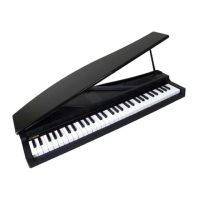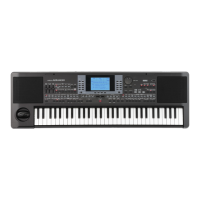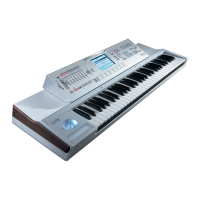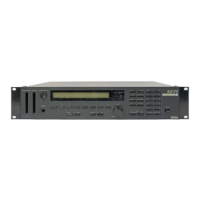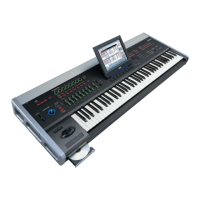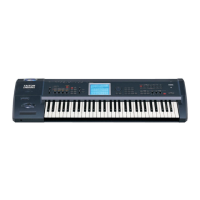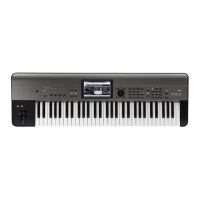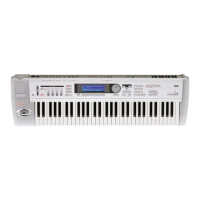53
Style Record mode
Style Import/Export
Going deeper into the Style structure, wecanseethat
eachChordVariationismadeupof TrackSequences,
andthemicroARRANGERsupports 8differenttracks.
DRUM and PERC are used for dru m and percussion
sequences, BASSfor bass and ACC1–5 are for accom
‐
paniment sequences (strin
g, guitar, piano or other
accompanimentinstruments).
Justtosummarize,whenyouplayachordonthechord
recognit
ion area, the arranger determines which Style
Element is used, then determines which Chord Varia‐
tion should be used for the play
ed chord, then Style
sequences for ev
ery track of that Chord Variation are
transposed from the original chord to the recognized
chordusingtheNTT,andsooneverytimeyouplaya
chord.
Note: The Br
eak and the Count Inare not Style Elements,
andcannotbeprogrammedbytheuser
.Whileinrecord/edit,
theBREAK/COUNTINbuttondoesnotwork.
What to record
RecordingaStyleisamatterofrecordingtracks,inside
aseriesofChordVariations,insideaseriesofStyleEle‐
ments,insidetheStyleitself.
Yo
u don’t need to record all Chord Va
riations for all
StyleElements.Itisoftenonlynecessarytorecordjust
a Chord Variation for each Style Element. Exceptions
are the Intro 1 and Ending 1, where we suggest to
recordbothaMajorandminorChordVariations.
STYLE IMPORT/EXPORT
You can use Korg’s Style To Midi application to
exchangeStylesbetweenyourcomputerandthe micro‐
ARRANGER, through the Standard
MIDI File (SMF)
format. The application is freely downloadable from
http://www.korgpa.com/. Please read the included
instructions.
ENTERING THE RECORD MODE
While in the Style Play operating mode, press
RECORD. The following page will appear in the dis‐
play:
• SelectCurrentStyletoeditthecurrentStyle.Ifitis
a Factor
y Style, youwill not be able to save it on
the original location; you will select a User Style
instead.
When editing an existing Style, the orig
inal Style
Performanceisrecalled,butthefollowingparame‐
ters are reset to their default val
ues: Drum Map‐
ping(0),Snare&KickDesignation(Off),Program
(Original),KeyboardRange(Original).Thismeans
that you can hear some differences between the
Style in play andthesameStylebeing edited; for
example,resettingtheDrumMappingmayleadto
someinstrument’sreplacement.
Aftered
itingtheStyle,pleasesav
eit(see“Exitand
Save/AbortStyle”below).Then,edittheStylePer‐
formancetoadjustthetrack’
ssettings(Tempo,Vol‐
ume,Pan
,FXSend…seepage43andfo llow ingin
the“StylePlayoperatingmode”chapter)andsave
itbypressingtheWRITEbutton.
• S
electNewStyletostartfromanew
,emptyStyle.
AdefaultStylePerformancewillberecalled.When
finished recording, you will save the new Style
ontoaUserStylelocation.
Afterrecordingthe Style,pleasesaveit (see “Exit
andSave/
AbortStyle”below).Then
,edittheStyle
Performancetoadju stthe track’s settings (Tempo,
Volume,Pan,FXSend…seepage43andfollowing
in the “Style Play operating mode” chapter) and
sav
eitbypressingtheWRITEbutton.
Note: After a record or edit operati
on, the Sty
le is
rewritten in memory. When you press START/STOP
there is a delay before you can actually listen to the
Style. This delay is higher with a Style containing
moreMIDIevents.
Note:WhileinRecordmode,allfootswitchesaredis‐
abled.
LISTENING TO THE STYLE WHILE IN
RECORD/EDIT MODE
WhileyouareinRecord/Editmode,youcanlistento
the selected Chord Variation or to the whole Style,
dependingonthepageyouarein.
To select a Chord Varia t io
n, go to the Main page of
the Record/Edit mode (see “E (Style Element)” and
“CV(ChordV
ariation)”onpage55).
•Whenyo
uareintheQuantize,Transpose,Ve
lo c ‐
ity,orDeletepages,youcanlistentotheselected
Chord Var
ia tion . Press START/STOP to check
how it works. Press START/STOP again to stop
theplayback.
•WhenyouareintheDeleteAll,Copy,StyleEle‐
ment Controls or St
yle Control pages, you can
listentothewholeStyl
e.PressSTART/STOPand
play some chords to do your tests. Select any
Style Element using the control panel buttons
(VARIATION 1–4, INTRO 1–2, FILL 1–2, END‐
ING 1
–2). Press START/STOP ag
ain to stop the
playback.
Note:Whendoingtheabovetests,theFingered3Chord
Scanningmodeisautomaticallyselected.
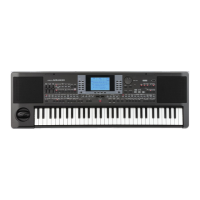
